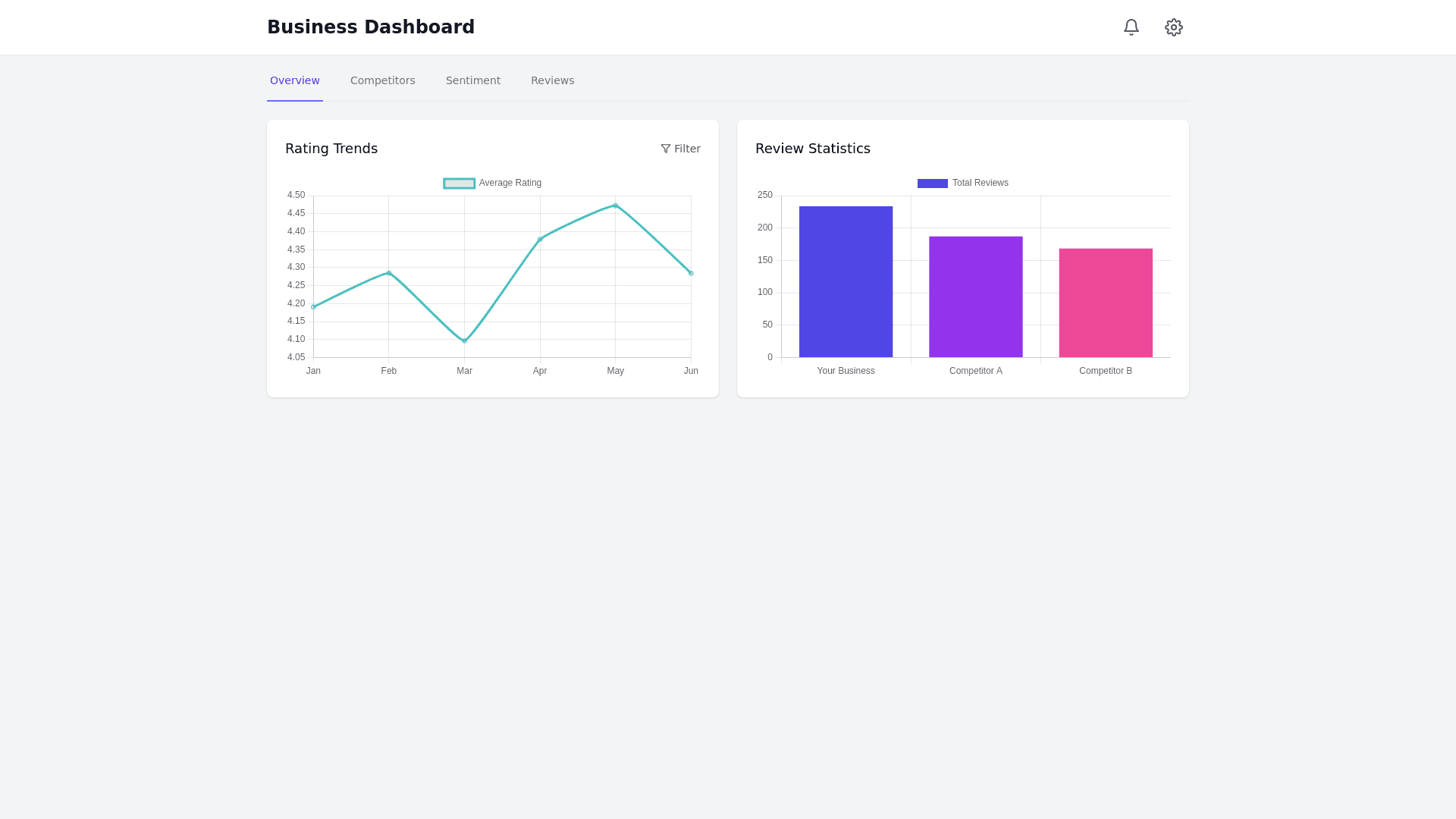Dashboard - Copy this React, Tailwind Component to your project
To-develop-multiple-workflows-for-the-Google-reviews-SaaS-application,-you-can-break-down-the-features-into-distinct-processes-and-then-create-workflows-that-can-handle-these-processes-efficiently.-Below-are-several-workflows-you-could-create-to-meet-the-needs-of-your-application:-1.-Review-Scraping-Workflow-•-Trigger:-When-a-user-adds-a-business-location-to-track.-•-Steps:-1.-Scrape-Google-Reviews:-Fetch-reviews-for-the-added-location-using-the-Google-Places-API.-2.-Filter-Reviews:-Store-reviews-based-on-predefined-criteria-(e.g.,-4+-stars-for-positive-reviews).-3.-Store-Data:-Save-reviews-in-the-database-for-further-analysis.-•-Output:-Raw-review-data-for-analytics-and-insights.-2.-Sentiment-Analysis-Workflow-•-Trigger:-When-new-reviews-are-fetched-or-periodically-(e.g.,-daily).-•-Steps:-1.-Analyze-Sentiment:-Use-a-natural-language-processing-(NLP)-model-(e.g.,-VADER,-Hugging-Face-transformers)-to-analyze-sentiment-in-reviews-(positive,-neutral,-negative).-2.-Store-Sentiment-Data:-Store-the-sentiment-score-alongside-each-review-for-later-use.-3.-Flag-Negative-Reviews:-Mark-reviews-with-negative-sentiment-for-further-attention-(e.g.,-alerts).-•-Output:-Sentiment-analysis-results-and-flagged-reviews-for-attention.-3.-Rating-Aggregation-Workflow-•-Trigger:-When-new-reviews-are-added-or-periodically-(e.g.,-every-week).-•-Steps:-1.-Aggregate-Ratings:-Calculate-average-ratings-and-NPS-(Net-Promoter-Score)-for-each-tracked-location.-2.-Store-Aggregated-Data:-Store-the-aggregated-ratings-for-dashboard-visualization.-3.-Trigger-Alerts:-If-a-significant-drop-in-ratings-occurs,-trigger-an-alert-for-the-user.-•-Output:-Aggregated-ratings-and-NPS-scores-displayed-on-the-dashboard.-4.-Competitor-Tracking-Workflow-•-Trigger:-When-a-user-adds-competitor-locations-to-track.-•-Steps:-1.-Fetch-Competitor-Reviews:-Use-Google-Places-API-to-scrape-reviews-for-competitor-locations.-2.-Analyze-Sentiment-for-Competitors:-Perform-sentiment-analysis-on-competitor-reviews.-3.-Compare-Metrics:-Compare-ratings-and-sentiment-scores-between-the-user’s-business-and-competitors.-4.-Store-Competitor-Data:-Store-competitor-data-for-comparative-insights.-•-Output:-Comparative-analysis-dashboard-showing-how-the-user’s-business-compares-to-competitors.-5.-Actionable-Insights-Workflow-•-Trigger:-When-new-reviews-are-scraped-or-sentiment-is-analyzed.-•-Steps:-1.-Identify-Key-Themes:-Analyze-the-most-common-positive-and-negative-themes-in-reviews-(e.g.,-service,-quality,-delivery).-2.-Generate-Insights:-Generate-actionable-insights,-such-as-improving-customer-service-based-on-recurring-complaints.-3.-Provide-Recommendations:-Offer-suggestions-on-what-the-business-can-do-to-improve-its-score-(e.g.,-respond-to-negative-reviews,-improve-specific-aspects-of-the-service).-•-Output:-Actionable-insights-and-recommendations-for-business-owners.-6.-Review-Response-Workflow-•-Trigger:-When-a-negative-review-is-flagged.-•-Steps:-1.-Generate-Suggested-Response:-Provide-a-suggested-template-for-responding-to-the-review-based-on-sentiment-and-the-specific-issue-raised.-2.-Send-Alert-to-User:-Notify-the-user-of-the-negative-review-and-the-suggested-response.-3.-Track-Response:-Allow-users-to-submit-their-response-to-the-review-through-the-platform-and-track-the-interaction.-•-Output:-Review-response-system-for-businesses-to-engage-with-customers.-7.-Predictive-Analytics-Workflow-•-Trigger:-Periodically-or-when-enough-data-is-available-(e.g.,-after-collecting-a-set-number-of-reviews).-•-Steps:-1.-Train-Predictive-Model:-Use-machine-learning-models-(e.g.,-time-series-forecasting)-to-predict-future-review-trends,-ratings,-or-sentiments.-2.-Generate-Predictions:-Predict-when-the-user-may-experience-spikes-or-drops-in-ratings.-3.-Provide-Predictions:-Provide-the-user-with-forecasts-about-their-business’s-rating-trends.-•-Output:-Predictive-analytics-dashboard-with-future-ratings-and-sentiment-projections.-8.-Customer-Insights-Workflow-•-Trigger:-Periodically-(e.g.,-every-week).-•-Steps:-1.-Analyze-Review-Trends:-Identify-recurring-issues-or-praise-across-reviews-(e.g.,-service-quality,-speed).-2.-Generate-Customer-Insights:-Aggregate-the-positive-and-negative-aspects-mentioned-by-customers.-3.-Provide-Insights:-Display-key-areas-of-improvement-and-highlight-strengths-to-help-businesses-focus-on-customer-experience.-•-Output:-Customer-insights-summary-for-business-owners.-9.-Alert-Workflow-•-Trigger:-When-a-significant-event-occurs-(e.g.,-a-drop-in-ratings,-a-new-negative-review).-•-Steps:-1.-Monitor-Metrics:-Monitor-review-scores,-sentiment,-and-overall-rating-metrics.-2.-Trigger-Alert:-Send-alerts-via-email-or-in-app-notification-if-certain-thresholds-are-met-(e.g.,-average-rating-falls-below-a-threshold,-multiple-negative-reviews-within-a-period).-•-Output:-Alerts-for-the-business-to-take-action.-Workflow-Automation-These-workflows-can-be-automated-using-tools-like:-•-Apache-Airflow-for-managing-tasks-and-scheduling-workflows.-•-AWS-Step-Functions-or-Google-Cloud-Workflows-for-orchestrating-complex,-multi-step-workflows.-•-Serverless-Functions-(e.g.,-AWS-Lambda,-Google-Cloud-Functions)-for-lightweight-workflows-triggered-by-specific-events-like-new-reviews.-User-Flow-Integration-Each-of-these-workflows-can-be-connected-to-user-actions.-For-example,-when-a-user-adds-a-new-location,-a-new-scraping-workflow-is-triggered,-followed-by-sentiment-analysis-and-review-aggregation-workflows.-By-defining-clear-workflows-for-each-feature,-you-can-build-a-system-that-efficiently-handles-scraping,-analysis,-and-insight-generation-for-your-Google-reviews-SaaS-application,-providing-a-seamless-experience-for-your-users.
